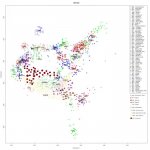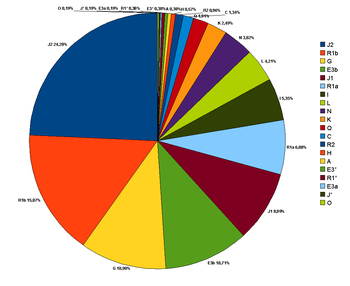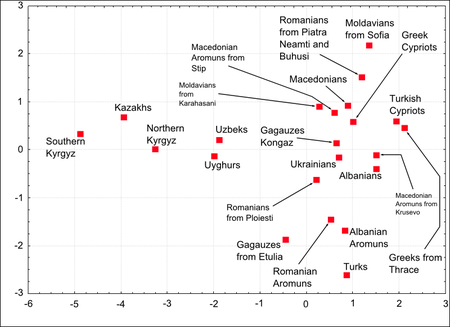Alan
Elite member
- Messages
- 2,517
- Reaction score
- 450
- Points
- 0
- Ethnic group
- Kurdish
- Y-DNA haplogroup
- R1a1a1
- mtDNA haplogroup
- HV2a1 +G13708A
Recently I had some thoughts about this matter. I asked myself how can despite the thousand years of contact and migration be a genetic gap between West Asians, Europeans and South Asians.
It wasn't really the genetic distance, since North Caucasians are as distant to Russians or Finns as non slavic speaking South Europeans. The difference was however that there was an absence of population which fill the gap between North Caucasians and Russians while there are populations like French, German and other Central and North Europeans who do it for their South European neighbors. There must have been in the past, populatians who filled the gap between East Europeans and North Caucasians as we have seen on samples from as early as Iron Age (IR1) from Hungary. But it wasn't only between North Caucasus and East Europe. There was an also smaller but yet visible gap between Anatolia and Southeast Europe.
Exactly the same observation I made when I looked at South Asian populations. I realized that Iranians and North Caucasians were not much more distant from some South Asians like Pashtuns as they were from Greeks/Russians or even each other. But again the only difference here was, there are populations which fill the gap between Iranians and North Caucasians while there were no Populations which would do the same with them and South Asians.
When I was looking at those PCA plots of West Eurasians suddenly I came to an idea. And the more I thought about it, the more sense it made.
Let's take a look at these PCA plots of West Eurasians.
http://blogs.discovermagazine.com/gnxp/files/2011/01/MDS1600.png
http://img5.fotos-hochladen.net/uploads/eumescalabeled9z7rwthsmc.jpg
http://blogs.discovermagazine.com/gnxp/files/2010/06/jewsnat1.png
http://oi52.tinypic.com/2cfaao3.jpg
Now lets ask ourselves which groups could have existed back than who now disappeard or were driven out/absorbed by newcowmers, and could have filled the gab. Initially I thought about the East Iranian tribes who once lived on the Pontic and Asiatic Steppes. Since they settled various land they must have also been the genetic gap fillers between East Europe, West Asia and South Asia. And than I asked myself who might have replaced them. And Turkic tribes came to my mind.
The more I thought about it the more obvious it became that first the Mongol and lather but more decisive the Turkic expansion, was not only the reason for the gap between West- South,- Central Asia and East Europe but also the reason for the gap between West Asia and the Balkans.
It makes completely, sense. Before the Turkic tribes appeared there was a group of ethnically related people, populating a vast land between East Europe, West Asia and South-Central Asia.
For example, if it wasn't for the East Asian admixture Turkmens and Tajiks would exactly plot between Afghans, Iranians and North Caucasians. The same with Anatolian Turks, if it wasn't for the up to 15%, East Asian admixture Western Anatolian Turks would cluster more in between Greeks and Armenians/Kurds/Georgians. Additional to that the Ottomans brought strong additional iranic admixture, into Central and West Anatolia while driving out a large part of Anatolian Greeks. I imagine Anatolian Greeks to have been geneticall exactly in between European Greeks and Armenians/Kurds/Georgians.
Than we have in the Eurasian Steppes the Turkic tribes, totally mixing with the East Iranic tribes in Asian Steppes and later replacing/driving out most of the Iranic tribes in the Pontic Steppes. This Strong Asian admixture created a gap. Later the Russians expanded into South Russia and Ukraine and drove out most of the Turkic speakers from the Pontic steppes. Which had the effect that a vast land once populated by ethnically related tribes (Iranic) was now seperated into a totally Russian (European) and Turkic (mostly East Eurasian) parts. If it wasn't for war, forced migration and total population replacement, there wouldn't have been this gap. A similar thing in same extent never happened inside Europe (expect Jews who however were not a major population in one, but big minority in many countries), West Asia or South-Central Asia. Sure we had the Arabic expansion but they mostly brought related Caucasian admixture but also only a few percentage. They never replaced the population in the same scale as Turkic speakers did in Central Asia for example.
Imagine a total population replacement in the Middle of Europe on vast land as it happened in the Eurasian Steppes during the middle ages. For example between South and North/Northeast Europeans. There would be a huge genetic gap in middle of Europe.
This is how most probably the genetic landscape of West Eurasia have looked like if it wasn't for total population replacements. So the gap between the West Eurasians is rather unnatural, than natural.

It wasn't really the genetic distance, since North Caucasians are as distant to Russians or Finns as non slavic speaking South Europeans. The difference was however that there was an absence of population which fill the gap between North Caucasians and Russians while there are populations like French, German and other Central and North Europeans who do it for their South European neighbors. There must have been in the past, populatians who filled the gap between East Europeans and North Caucasians as we have seen on samples from as early as Iron Age (IR1) from Hungary. But it wasn't only between North Caucasus and East Europe. There was an also smaller but yet visible gap between Anatolia and Southeast Europe.
Exactly the same observation I made when I looked at South Asian populations. I realized that Iranians and North Caucasians were not much more distant from some South Asians like Pashtuns as they were from Greeks/Russians or even each other. But again the only difference here was, there are populations which fill the gap between Iranians and North Caucasians while there were no Populations which would do the same with them and South Asians.
When I was looking at those PCA plots of West Eurasians suddenly I came to an idea. And the more I thought about it, the more sense it made.
Let's take a look at these PCA plots of West Eurasians.
http://blogs.discovermagazine.com/gnxp/files/2011/01/MDS1600.png
http://img5.fotos-hochladen.net/uploads/eumescalabeled9z7rwthsmc.jpg
http://blogs.discovermagazine.com/gnxp/files/2010/06/jewsnat1.png
http://oi52.tinypic.com/2cfaao3.jpg
Now lets ask ourselves which groups could have existed back than who now disappeard or were driven out/absorbed by newcowmers, and could have filled the gab. Initially I thought about the East Iranian tribes who once lived on the Pontic and Asiatic Steppes. Since they settled various land they must have also been the genetic gap fillers between East Europe, West Asia and South Asia. And than I asked myself who might have replaced them. And Turkic tribes came to my mind.
The more I thought about it the more obvious it became that first the Mongol and lather but more decisive the Turkic expansion, was not only the reason for the gap between West- South,- Central Asia and East Europe but also the reason for the gap between West Asia and the Balkans.
It makes completely, sense. Before the Turkic tribes appeared there was a group of ethnically related people, populating a vast land between East Europe, West Asia and South-Central Asia.
For example, if it wasn't for the East Asian admixture Turkmens and Tajiks would exactly plot between Afghans, Iranians and North Caucasians. The same with Anatolian Turks, if it wasn't for the up to 15%, East Asian admixture Western Anatolian Turks would cluster more in between Greeks and Armenians/Kurds/Georgians. Additional to that the Ottomans brought strong additional iranic admixture, into Central and West Anatolia while driving out a large part of Anatolian Greeks. I imagine Anatolian Greeks to have been geneticall exactly in between European Greeks and Armenians/Kurds/Georgians.
Than we have in the Eurasian Steppes the Turkic tribes, totally mixing with the East Iranic tribes in Asian Steppes and later replacing/driving out most of the Iranic tribes in the Pontic Steppes. This Strong Asian admixture created a gap. Later the Russians expanded into South Russia and Ukraine and drove out most of the Turkic speakers from the Pontic steppes. Which had the effect that a vast land once populated by ethnically related tribes (Iranic) was now seperated into a totally Russian (European) and Turkic (mostly East Eurasian) parts. If it wasn't for war, forced migration and total population replacement, there wouldn't have been this gap. A similar thing in same extent never happened inside Europe (expect Jews who however were not a major population in one, but big minority in many countries), West Asia or South-Central Asia. Sure we had the Arabic expansion but they mostly brought related Caucasian admixture but also only a few percentage. They never replaced the population in the same scale as Turkic speakers did in Central Asia for example.
Imagine a total population replacement in the Middle of Europe on vast land as it happened in the Eurasian Steppes during the middle ages. For example between South and North/Northeast Europeans. There would be a huge genetic gap in middle of Europe.
This is how most probably the genetic landscape of West Eurasia have looked like if it wasn't for total population replacements. So the gap between the West Eurasians is rather unnatural, than natural.

Attachments
Last edited:








